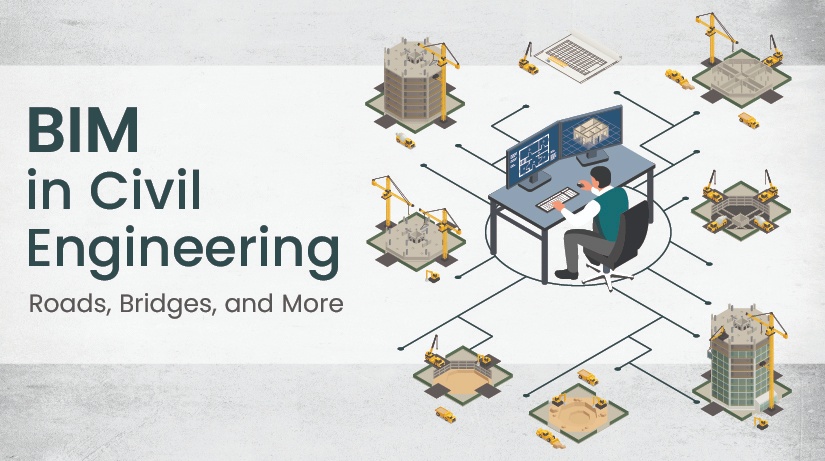BIM in Civil Engineering: Roads, Bridges, and More
Oct 16, 2023
Category: BIM / Digitization / Automation
SEO TSA

In the ever-evolving world of civil engineering, staying at the forefront of technological advancements is crucial. Building Information Modeling (BIM) is one such innovation that has transformed the way civil engineers plan, design, construct, and manage infrastructure projects.
In this blog, we will delve into the world of BIM and its applications in civil engineering, with a focus on roads, bridges, and more.
Understanding BIM in Civil Engineering
Before we dive into its applications, let’s define what BIM is. To start with, BIM is a digital representation of the physical and functional characteristics of a building or infrastructure. It’s beyond just a 3D model; it’s a comprehensive database of information that covers everything from design and construction to operation and maintenance. BIM allows all stakeholders involved in a project to collaborate seamlessly, resulting in improved efficiency, reduced errors, and cost savings.
Applications of BIM in Civil Engineering
Design and Planning:
BIM revolutionizes the design process. Engineers can create accurate 3D models of roads, bridges, and other infrastructure, enabling them to visualize the project better. This enhances the decision-making process as potential issues can be identified and addressed early in the design phase, reducing costly revisions later.
Collaboration:
BIM promotes collaboration among project stakeholders. Architects, engineers, contractors, and even owners can access the same data-rich model, fostering better communication and coordination. This leads to smoother project execution and improved project outcomes.
Cost Estimation and Budgeting:
BIM aids in accurate cost estimation by providing a detailed breakdown of materials and quantities. This helps in better budgeting and reduces the risk of cost overruns.
Construction Management:
During construction, BIM can be used for scheduling and sequencing tasks. It assists in optimizing construction processes, tracking progress, and identifying potential conflicts, ensuring projects stay on time and on budget.
Maintenance and Operations:
BIM isn’t just for the construction phase. It continues to be valuable during the lifetime of the infrastructure. Maintenance teams can access the BIM model to identify maintenance requirements and access information about the components of the structure.
Specific Applications in Roads and Bridges
Alignment and Grading:
BIM can optimize road alignments and grading, taking into account factors like terrain, drainage, and environmental considerations. This ensures that roads are not only functional but also sustainable.
Bridge Design:
BIM can be used to design complex bridge structures, helping engineers visualize load distribution and stress analysis. It also assists in clash detection, ensuring that all components fit together seamlessly.
Traffic Simulation:
BIM can incorporate traffic simulation data to evaluate the efficiency of road systems and make necessary adjustments to improve traffic flow.
Asset Management:
For existing roads and bridges, BIM helps in asset management by providing accurate data on the condition of structures and predicting maintenance needs.
Popular BIM software used by civil engineers
AutoCAD Civil 3D:
AutoCAD Civil 3D is a widely used BIM software for civil engineering and design. It’s known for its capabilities in designing, drafting, and managing civil engineering projects.
Revit:
Revit by Autodesk is a versatile BIM software commonly used for architectural and structural design but can also be employed in civil engineering projects, especially for integration with other Autodesk products.
Bentley MicroStation:
Bentley MicroStation is a BIM and CAD software used in various civil engineering disciplines, including transportation, utilities, and construction.
Tekla Structures:
While primarily known for structural engineering, Tekla Structures can be used in civil engineering for designing and detailing concrete and steel structures.
InfraWorks:
Autodesk’s InfraWorks is specialized for civil infrastructure projects, helping with preliminary design, visualization, and collaboration.
Civil 3D:
AutoCAD Civil 3D, as mentioned earlier, is a specialized AutoCAD version tailored for civil engineering, including land development, transportation, and environmental projects.
Allplan Engineering:
Allplan Engineering is a BIM software that caters to civil engineering and infrastructure projects, offering tools for design, modeling, and documentation.
OpenRoads:
Bentley’s OpenRoads is designed for civil engineers working on transportation and road design projects, providing comprehensive modeling and analysis capabilities.
Civil Site Design (CSD):
Civil Site Design is a software suite for civil engineers, specializing in land development and site design.
HEC-RAS:
While not a traditional BIM software, the Hydrologic Engineering Center’s River Analysis System (HEC-RAS) is essential for hydraulic and floodplain modeling, which is crucial in many civil engineering projects.
SAP2000:
While primarily used for structural analysis, SAP2000 can be utilized in civil engineering for the analysis and design of bridges and other civil structures.
How does BIM benefit civil engineer’s careers?
● Enhanced Collaboration:
BIM improves teamwork and communication among project stakeholders.
● 3D Visualization:
It provides realistic 3D models for better design assessment and error detection.
● Cost Estimation:
BIM tools aid in accurate cost estimation and budget management.
● Streamlined Documentation:
It automates documentation, saving time and reducing errors.
● Clash Detection:
BIM identifies clashes early, preventing costly construction issues.
● Sustainability Analysis:
Engineers can assess and optimize designs for sustainability.
● Project Lifecycle Management:
BIM supports project management from concept to maintenance.
● Career Opportunities:
BIM proficiency enhances job prospects and earning potential.
● Competitive Edge:
Firms using BIM can secure more projects and offer better solutions.
● Professional Development:
BIM training and certification foster skill growth and industry relevance.
Demand for BIM in Civil Engineering
● Improved Collaboration:
BIM facilitates collaboration among project stakeholders, including architects, engineers, contractors, and owners, leading to better communication and coordination.
● Efficient Design and Analysis:
BIM allows for the creation of 3D models that enable engineers to visualize and analyze structures, leading to better design decisions and reduced errors.
● Cost Savings:
BIM helps identify potential clashes and conflicts early in the design phase, minimizing costly rework during construction.
● Sustainability:
BIM enables the evaluation of sustainable design options, helping civil engineers make environmentally responsible choices.
● Project Lifecycle Management:
BIM supports the entire project lifecycle, from planning and design to construction and maintenance, improving asset management.
● Regulatory Compliance:
BIM helps ensure compliance with building codes and regulations, reducing the risk of legal issues and delays.
● Risk Mitigation:
By providing a comprehensive view of the project, BIM helps identify and mitigate risks before they escalate.
● Data Integration:
BIM integrates various data sources, such as geospatial information and IoT sensors, enhancing decision-making and maintenance.
● Global Trends:
Many countries mandate or incentivize the use of BIM in public infrastructure projects, increasing its adoption.
● Client Expectations:
Clients increasingly demand BIM to optimize project outcomes, reduce costs, and ensure long-term asset performance.
● Technological Advancements:
Advances in BIM software and hardware make it more accessible and practical for civil engineering projects of all sizes.
● Competitive Advantage:
Firms that embrace BIM gain a competitive edge by delivering higher-quality projects more efficiently.
Benefits of BIM for Civil Engineers
● Enhanced Collaboration:
BIM promotes better communication and collaboration among multidisciplinary teams, including architects, structural engineers, and contractors.
● Improved Visualization:
3D models help engineers visualize projects more accurately, reducing design errors and improving decision-making.
● Clash Detection:
BIM software identifies clashes and conflicts in design, helping prevent costly on-site errors and rework.
● Cost Estimation:
BIM facilitates more accurate cost estimations throughout the project’s lifecycle, aiding in budget management.
● Project Efficiency:
BIM streamlines workflows and automates repetitive tasks, saving time and increasing productivity.
● Sustainability:
BIM allows for better analysis of environmental impacts and energy efficiency, supporting sustainable design decisions.
● Lifecycle Management:
BIM can be used for facility management, making it easier to maintain and operate civil infrastructure over its lifespan.
● Risk Reduction:
BIM helps identify and mitigate risks early in the design and construction phases.
● Regulatory Compliance:
Ensures compliance with building codes and regulations, reducing the likelihood of legal issues.
● Data Integration:
BIM integrates various project data, enabling informed decision-making and performance analysis.
● Asset Management:
Supports effective management of civil infrastructure assets, optimizing their use and maintenance.
● Client Communication:
BIM facilitates clearer communication with clients, helping them understand and visualize project details.
● Documentation and Reporting:
Generates detailed documentation and reports for better project tracking and reporting.
● Quality Control:
BIM helps maintain quality standards by providing a comprehensive overview of project details.
● Future Proofing:
Allows for easy updates and modifications to adapt to changing project requirements or technological advancements.
Challenges and Future Outlook
While BIM has brought about significant advancements in civil engineering, it’s not without its challenges. These include the initial investment in technology and training, interoperability issues between different software platforms, and the need for standardized data exchange formats.
However, the future of BIM in civil engineering looks promising. As technology continues to evolve, BIM will become even more integrated into the industry. The use of Artificial Intelligence (AI) and Internet of Things (IoT) will further enhance the capabilities of BIM, enabling real-time monitoring and predictive maintenance.
Conclusion
In conclusion, BIM is a game-changer in civil engineering, transforming the way infrastructure projects are conceived, designed, built, and maintained. Roads, bridges, and other civil engineering projects benefit from BIM’s ability to enhance collaboration, improve accuracy, and streamline processes. As the technology continues to evolve, it’s clear that BIM will play an increasingly vital role in shaping the future of civil engineering.
FAQs
Q1) Can BIM be used for bridges?
A) The purpose of the bridge BIM model is to provide an asset model of the structure, containing relevant information and data captured throughout the delivery stages, allowing the department to efficiently and effectively manage the asset.
Q2) Can BIM be used for roads?
A) Using BIM for road and highway design facilitates the integration of geotechnical studies into the design process. With the help of the BIM model, designers can assess soil properties, stability considerations, and potential risks.
Q3) What is BIM for civil engineering?
A) BIM stands for Building Information Modeling. For civil engineers, BIM is a process that incorporates all the various design disciplines and allows them to create a complete, intelligent model of the infrastructure project. BIM is the foundation for digital transformation in the civil engineering industry.
Q4) What is the current use of BIM?
A) BIM course for civil engineers is a game-changer in the construction industry due to its ability to enhance collaboration, improve communication, and streamline workflows. By providing a common platform for all project participants, BIM fosters a collaborative environment, eliminating discrepancies and reducing errors.








